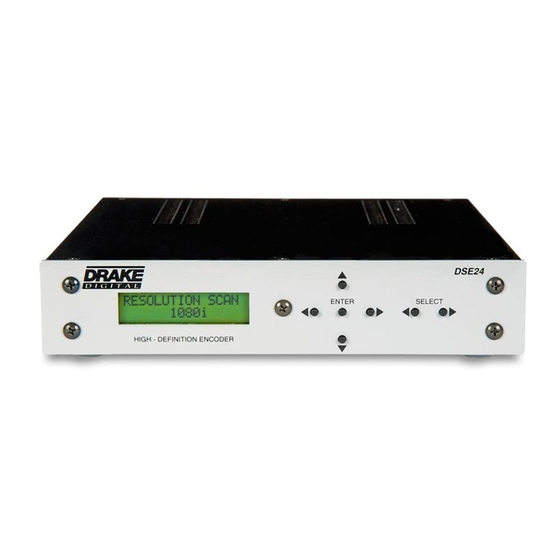DRAKE DSE24 Kullanım Kılavuzu - Sayfa 10
Medya Dönüştürücü DRAKE DSE24 için çevrimiçi göz atın veya pdf Kullanım Kılavuzu indirin. DRAKE DSE24 20 sayfaları. Hd encoder with closed captioning

10 Setup and Programming (continued)
BRIGHTNESS, CONTRAST, SATURATION and HUE: these menu items allow the user to assign the
brightness, Contrast, and Saturation parameters of the output video values from 0 to 255 with 128 being the
default. the range and default values for Hue depends on the ViDeo iNPut mode. if Composite is selected, the
range is 0 to 255. for all other ViDeo iNPut modes, the range is 0 to 128.
HORIZ SHIFT: this item allows the user to center the video horizontally in the outputted video signal. the values
are from -300 to +300. this menu item will not appear if Composite or Component video input is selected.
HORIZ WIDTH: this item provides the means for the user to adjust the width of the outputted video. the values
are from -300 to +300. this menu item will not appear if Composite or Component video input is selected.
AUDIO INPUT: the user may use this menu item to select the type of audio to be encoded. the selections are
HDmi, S/PDif, and ANALoG. Audio input jacks are provided on the rear panel for analog (see R4 on page 8),
and S/PDif (see R3 on page 8). in the case of HDmi, the audio is encoded along with the video and is inputted
via the HDmi jack on the rear panel (see R8 on page 7).
QAM MODE: this menu allows the user to set the modulation type for the output. Choices are qAm-64b or
qAm-256b. the b suffixes indicate DigiCipher ii feC encoding. for CAtV systems using DigiCipher ii, select the
qAm-256b mode.
INTERLEAVER: this menu item provides the means to set the qAm modulator interleaver. Choose among the
available selections based upon your system / set top box requirements. for typical 256-qAm DigiCipher ii CAtV
systems, i128, J1 is the most commonly used interleave setting but many other choices are available.
OUTPUT FORMAT: for normal operation, select NoRmAL. for system level set up, choose Cw to provide
a Cw carrier at the center frequency of the output channel for use in leveling a system when a qAm power
meter is not available. to disable all Rf output, select StANDby. in the Cw mode, the Cw carrier can be
measured on a spectrum analyzer without a need to apply a bandwidth correction or it can be measured with
an analog meter tuned to channel center. the Cw power measured will equal the channel qAm power when
the modulator is returned to NoRmAL output mode. usually qAm signals are set 5 db to 10 db below analog
NtSC channels when balancing a system.
OUTPUT CHANMAP, OUTPUT CHANNEL: Select the desired eiA CAtV channel output using these two
menus.
OUTPUT LEVEL: Select the desired Rf output signal level. the available range is between +29.5 dbmV and
+45 dbmV, selectable in 0.5 db steps. the output accuracy is ± 1 db.
MGT/VCT ENABLE: this menu item provides a means for the user to select tVCt, CVCt 1-PARt VCN,
CVCt 2-PARt VCN tables or DiSAbLeD for qAm operation. tVCt is the typical setting.
CHANNEL NAME: the user can use this menu entry to name the channel. to do so, go to program mode by
holding down the ENTER key until the bottom line of the display starts flashing. Then use the UP and DOWN
keys to select the alphanumeric character and use the SeLeCt keys to move the cursor to the desired
position in the channel name. the channel name cannot exceed 7 characters including any punctuation
characters. this menu will not appear if 'Disabled' is selected in the mGt/VCt eNAbLe menu.
MAJOR CHANNEL: this menu allows the user to select on which major channel the encoded audio and
video information will appear. the choices are 1 through 999. if the mGt - VCt menu is set to 'DiSAbLe', this
screen will not appear. if the 'mGt-VCt eNAbLe' menu is set to 'CVCt 1-PARt VCN' a single 'CHANNeL
NumbeR' window will appear.
